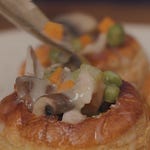Chef Mike is the best kept secret in a professional kitchen. He always shows up, doesn’t do drugs, works hard and won’t harass the servers. But, what about the radiation?! So much undo fear and hysteria used to surround this magic device for years and none of it is rooted in reality. People used to call using the microwave “nuking” food and thats simply not how it works.
The term "radiation" often triggers concerns, but it's important to clarify what it means in this context. Radiation simply refers to the emission of energy as waves or particles. There are different types of radiation, and not all are harmful. For example:
Ionizing Radiation (like X-rays and gamma rays) has enough energy to remove tightly bound electrons from atoms, which can cause damage to living tissue.
Non-Ionizing Radiation (like microwaves, radio waves, and visible light) does not have enough energy to ionize atoms or molecules and therefore does not carry the same risks as ionizing radiation.
Microwaves Are Non-Ionizing: The microwaves used in your oven are non-ionizing, meaning they don’t have enough energy to cause chemical changes or damage to the molecules in your body. They only generate heat by making the water molecules in food vibrate, which is why they're safe for cooking.
Inside the microwave oven, there's a component called a magnetron. This device generates microwaves, which are a form of electromagnetic waves, similar to radio waves but with a much shorter wavelength. Microwaves are particularly effective at exciting water molecules. When the microwaves hit the water molecules in the food, they cause the molecules to vibrate rapidly. This vibration generates heat, which cooks the food.
Cooking food in a microwave doesn’t make it radioactive or harmful. The process is simply a form of heating, much like boiling or baking. The food retains its nutritional value, and there’s no scientific evidence that microwave cooking poses any health risks.
Butter poached lobster
2 lobster tails, split down the middle
6 tablespoons unsalted butter
1 tablespoon olive oil
2 sprigs of thyme
1/2 teaspoon salt
1/4 lemon to finish or to your taste
Freshly chopped chives or parsley to finish
Add the butter, olive oil, thyme, garlic and salt to a shallow microwave safe container, mash it down so its flat. Place the lobster tails cut side down and cover. Cook on power level 5 for about 3 minutes depending on your microwave. If not done to you liking after 3 minutes, do 20 sec bursts until you reach your desired doneness. A visual key is that the shell should be bright red. Carefully place the tails into a bowl or plate and spoon the butter on top, followed by the herbs and lemon
Compound butter
8 ounces salted butter
6 cloves of garlic minced
1/4 cup freshly minced herbs chive, parsley etc
Zest of 1 lemon
Soften the butter slightly in the microwave in 20-30 second bursts, it should not get completely melted, just soft enough to fold the aromatics in. Stir everything well to combine, place on a piece of plastic wrap and roll into a cylinder and pop in the freezer. You can also tip the butter mixture into ramekins and cover for future use at a dinner party, keep in the fridge if using this option.
Confit Tomatoes
2 cups cherry tomatoes
2-3 tablespoons olive oil
Salt to taste
Pinch of garlic powder
1 sprig of thyme
Place everything in a microwave safe bowl and cook uncovered for 8-10minutes, until the tomatoes start to shrink. Cool and enjoy on toast, pizza, eggs, pasta and more. They can be eaten warm or cold
Corn on the cob
1-2 corn on the cob in their husk
Compound butter
Place the corn in the microwave and microwave on high for 3-4 minutes. Carefully remove the husk and slather with the compound butter and enjoy













Share this post